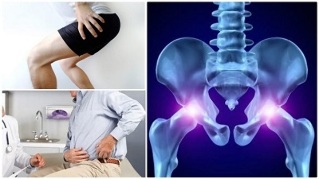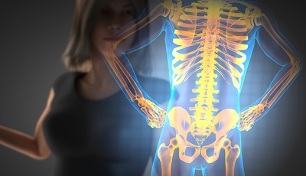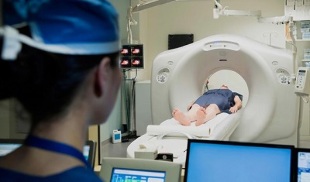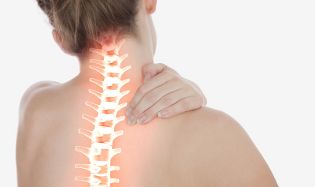Osteochondrosis or chondrosis is a disease that reduces the elasticity of cartilage in the joints. The disease can manifest in any joint and has its own classification depending on the location. Progression of the disease leads to impaired motor function of the joint, often resulting in complete immobility.
The symptoms, causes and methods of treating osteochondrosis are discussed in the information provided.
How does osteochondrosis manifest itself
Signs of osteochondrosis appear gradually, first with a mild pain syndrome that later becomes chronic and intense. Usually, patients seek medical attention for complaints about severe pain and the inability to perform certain movements.
In order to treat osteochondrosis as effectively as possible, the disease must be diagnosed at an early stage.
The following signs may indicate the development of osteochondrosis:

- Pain on movement;
- Cracking of joints;
- Stiffness of movement;
- Muscle cramps;
- Headache, increased blood pressure and dizziness (with osteochondrosis of the neck);
- Pain in the chest and between the shoulder blades (chest osteochondrosis);
- Hip and buttock pain (lumbosacral osteochondrosis and hip joint);
- Limb numbness;
- Bone pains;
- Increase weather sensitivity;
- Decreased visual acuity.
Usually, the first manifestations of the disease go unnoticed. Therefore, the initial stage of osteochondrosis is rarely diagnosed and is usually completely accidental.
Causes of osteochondrosis
Osteochondrosis does not occur spontaneously. Degenerative processes of the joint lead to its development, namely: disruption of normal blood circulation and mineral metabolism, ossified formations - the formation of osteophytes. All this leads to immobility of the joint, changes in its structure, and the appearance of unpleasant feelings during movement and walking.
Main reasons for appearance:
- Lack of constant physical activity;
- Joint injuries and injuries;
- Joint deformity under excessive stress;
- Nutritional and blood supply disorders of the joint;
- Overweight problems;
- Unbalanced diet;
- Chronic stress;
- Hereditary predisposition;
- Endocrine pathologies;
- Age-related changes;
- Adverse working conditions (prolonged discomfort, hypothermia, heavy lifting).
Patients with flat feet, congenital or acquired foot developmental pathologies have an increased risk of developing the disease. In such diseases, the load during walking is incorrectly distributed, which leads to a change in normal gait and, as a result, deformity of the spine, knee, and hip joints.
The incidence of osteochondrosis of the spine is directly related to already diagnosed diseases of the musculoskeletal system, such as scoliosis.
In addition, chronic diseases of the internal organs can act as a provoking factor. Infections and inflammations can affect nearby tissues, leading to the development of pathology in the joint joints.
Classification of osteochondrosis

The definition of "spinal chondrosis" is often found in medical terminology. This refers to the initial stage of osteochondrosis, which affects one (or more) classes of the spine. The pathology develops in the intervertebral disc and does not affect nearby tissues. This is a particular insidiousness of back chondrosis, as the asymptomatic onset does not provide a chance to start treatment accurately and fight the disease.
Usually, chondrosis, the symptoms of which have not yet appeared, can be discovered quite by accident in a comprehensive examination of the body.
In addition, depending on the localization of the pathology, we can talk about coxarthrosis - osteochondrosis of the hip joint. The pathology can also affect the shoulder or the accumulated joint. And osteochondrosis of the back is also classified by location.
What are the types of posterior osteochondrosis:
- Cervical osteochondrosismanifests as pain and stiffness between the neck, the back of the head and the shoulder blades. It is often seen as an occupational disease for accountants, computer programmers, and other occupations that involve a lengthy session.
- chest osteochondrosisis quite rare. Due to the relative immobility of this area, symptoms are often confused with angina pectoris or intercostal neuralgia. In addition, manifestations of chest osteochondrosis may resemble an attack of pancreatitis or gastritis.
- lumbar or lumbosacral osteochondrosisis the most common type of disease. This is due to the increased stress in this department, even when performing normal movements. With increasing load, weight lifting, sports, the pressure on the vertebrae of the lumbar spine often increases, which can provoke the development of the disease. Manifestations of lumbar osteochondrosis are extremely diverse. The main symptoms are not only pain in bending, turning and other movements, but also muscle atrophy, difficulty walking, decreased sexual function and diseases of the urinary system.
- Coccyx osteochondrosisis a rare disease that primarily affects women. This is directly related to the physiological characteristics of the pelvic structure. Pain syndrome is defined when you sit, walk and perform physical exercises. Action is usually preceded by injuries and falls, as well as prolonged residence in an uncomfortable sitting position.
- Polysegmental osteochondrosisis diagnosed when degenerative changes in nearby joints are detected. They may be located in one or more parts of the spine.
- Widespread osteochondrosismanifests as lesions in two or more parts of the spine. A disease that is difficult to treat, with a low chance of complete recovery.
- Diffuse osteochondrosiscan be diagnosed if the pathology spreads to all segments of the spine.

Progressive disease is not just about pain and discomfort while moving. Inflammation of the connective tissue of the joint develops, the intervertebral roots pinch, and growths of bone tissue — osteophytes — begin to form in the vertebrae.
Stages of osteochondrosis development
In order to determine tactics for the treatment of osteochondrosis, not only the exact diagnosis but also the degree of involvement of joint elements in the pathological process should be determined. For this purpose, it is customary to use classification according to degrees as well as the location of the pathology.
What type of osteochondrosis is it:
- The initial stagedoes not manifest as a pain syndrome and does not require specific treatment. According to statistics, the first stage of osteochondrosis is present in more than 80% of the population over 50 years of age. Recently, osteochondrosis has been diagnosed in almost every second person under the age of 30 due to the proliferation of occupations requiring permanent sitting and a decrease in the physical activity of children and adolescents.
- The second stagecan be diagnosed by osteochondrosis X-ray. The image shows the formation of multiple fractures of the intervertebral disc, but the fibrous ring remains intact. Manifestations of the disease are insignificant, it usually causes discomfort by staying in a long sitting or standing position, after a short rest the pain disappears on its own. The diagnosed second stage of osteochondrosis can be treated with great success using conservative methods.
- The third stage of osteochondrosisis characterized by numerous lesions of the intervertebral disc and possible rupture of the annulus fibrosus. The pains become prolonged and permanent and may even appear at rest. Treatment of osteochondrosis in the third stage is performed using conservative and surgical methods, the prognosis depends on the severity of the pathology and the timely treatment of medical assistance.
- The fourth stageosteochondrosis is the most severe. It is determined by severe changes in the structure of the joint. The ligaments, blood vessels, nerve endings, and connective tissues of the joint are involved in the pathological process. Conservative methods are generally ineffective. Surgery is used more often, but even surgery does not guarantee healing, patients often lose joint mobility and remain disabled.

In order to prevent the transition of osteochondrosis to the critical stage, it is essential to pay attention in time to the signals given by the body. There are cases where patients endure pain and discomfort for years and adapt to limit motor function but do not seek medical attention.
It should be noted that osteochondrosis is not a disease that can be cured at home alone by folk methods or only with painkillers.
A mandatory comprehensive approach is needed, defined by the characteristics of the pathology, the causes of its occurrence, and the patient's individual indicators.
Diagnosis of osteochondrosis
Special studies should be performed to ensure the correct tactics for the treatment of osteochondrosis. They will help identify the localization and causes of the disease. You can only start the main treatment after eliminating the negative factors that affect the progression of the disease.
How to determine the extent and location of the pathological process:

- X-ray examination.Images need to be captured in multiple projections for reliable information. They determine the location and extent of joint damage, the presence of osteophytes, and the condition of the bone ducts.
- Doppler ultrasound.Check for blood supply disorders, vascular integrity, and blood flow rate.
- Myelography.Special examination of the spine using contrast material. It allows the identification of intervertebral hernias and their localization.
- Computed tomography.Check the condition of the intervertebral discs, any structural and deformation abnormalities, pinching of the nerve roots, and changes in the structure of each vertebra.
- Magnetic resonance imaging.It usually provides a more detailed study of the structure of the joints. Available if the information content of other studies performed is low. An undoubted advantage is a more detailed examination of the condition of the soft parts.
The patient's medical history is also examined without failure. Possible injuries, even before consulting a doctor, surgeries and chronic diseases can also cause the development of pathological processes in the joint tissues.
In addition, a personal examination and interrogation of the patient are performed. Based on the information obtained, the diagnosis and extent of joint damage are determined.
How to treat osteochondrosis
After diagnosing osteochondrosis and identifying its causes, the practitioner will create an individual treatment plan. It must take into account the physical characteristics of the patient, the peculiarities of the development and localization of the pathology.

An integrated approach is used during treatment.
Medicines alone should not be dispensed with, because at the same time joint mobility must be improved, possible inflammatory processes in the surrounding tissues must be eliminated and the negative factor leading to the development of the disease must be neutralized.
Therefore, it is better to entrust the treatment of chondrosis to a specialist who selects an individual set of exercises and also takes into account the dynamics of the therapy.
Drug therapy for osteochondrosis
The prescription of drugs depends on the type of lesion and the pathological processes that occur in the tissues. As a general rule, patients should try to treat osteochondrosis on their own, with pharmaceutical and homemade ointments and compresses, as well as folk remedies.
Unfortunately, this is only a temporary relief and does not contribute to the complete elimination of diseases. The following classes of drugs are used to effectively treat osteochondrosis.
Medication includes:
- Systemic and local anesthetics.These include ointments and compresses, as well as tablets and injections to treat severe pain syndrome. It is used to treat osteochondrosis during exacerbations.
- NSAIDs- Non-steroidal anti-inflammatory drugs are used not only to relieve pain and inflammation in the affected area, but also when the temperature is caused by the disease.
- The effect of muscle relaxantsis to relieve muscle tone. Medications in this group are taken in 30-45 day courses and dosing is strictly prescribed individually. They usually start with a minimal dose (injections are prescribed for severe hypertension), which are gradually increased. In order not to cause withdrawal syndrome, the dose is then gradually reduced.
- chondroprotectorshelp repair cartilage tissue by compensating for damaged areas. The effect of this group of drugs does not appear immediately, so several months of treatment is prescribed. There are different forms of medication. During the period of exacerbation, it is given as an injection and then the treatment is continued with tablets or capsules.
- Angioprotectorsare used for identified pathologies of the blood supply. They help strengthen the walls of blood vessels, help them relax and restore metabolism. The duration of the recording is also several months.
- Glucocorticosteroidsare prescribed to enhance the action of NSAIDs and muscle relaxants. They have a pronounced anti-inflammatory and decongestant effect, helping against pain and cramps. The course of treatment is determined individually. In the first days when the disease gets worse, they are used in the form of injections and then in the form of tablets. The dose is gradually reduced until the medicine stops completely.
- Biogenic stimulants.They speed up metabolism and help repair joint tissue. Self-treatment of chondrosis at home with such drugs is impossible, but they have been shown to be effective in complex therapy.
- Complex vitamin preparations.Helps to strengthen the body overall and speed up metabolic reactions.

Is osteochondrosis treated with medication alone? Of course not. Other medical procedures must be performed to completely get rid of the disease. Particular attention should be paid to a special set of exercises. It has been developed for all sections of the spine or joint joints of the limbs.
Important point:classes are performed under the supervision of a specialist and only after the inflammation of the affected area has been removed.
Physiotherapy
What to do in osteochondrosis and what movements are better to refuse, says a specially trained specialist. Initially, the exercises are performed under his direction and then the patient can continue to exercise.
Treating osteochondrosis at home involves regular exercise to restore joint mobility.
Massage and physiotherapy
Many methods of alternative medicine are also used to treat osteochondrosis of the spine. These include mud packs, acupuncture, magnetotherapy, manual therapy.
.jpg)
Among the medical procedures, drug electrophoresis, laser therapy and heat therapy are often used. An important aspect is the health management of special sanatoriums.
What is osteochondrosis? More and more patients are getting to know this disease at a young age. Sedentary lifestyle, decreased muscle tone and uneven loads in the joints - the weight of these negative factors lead to the development of degenerative processes in the structure of cartilage tissue.
Decreased flexibility and violation of its integrity are manifested by constant or intermittent pain, stiffness, and even malfunction of internal systems.



































